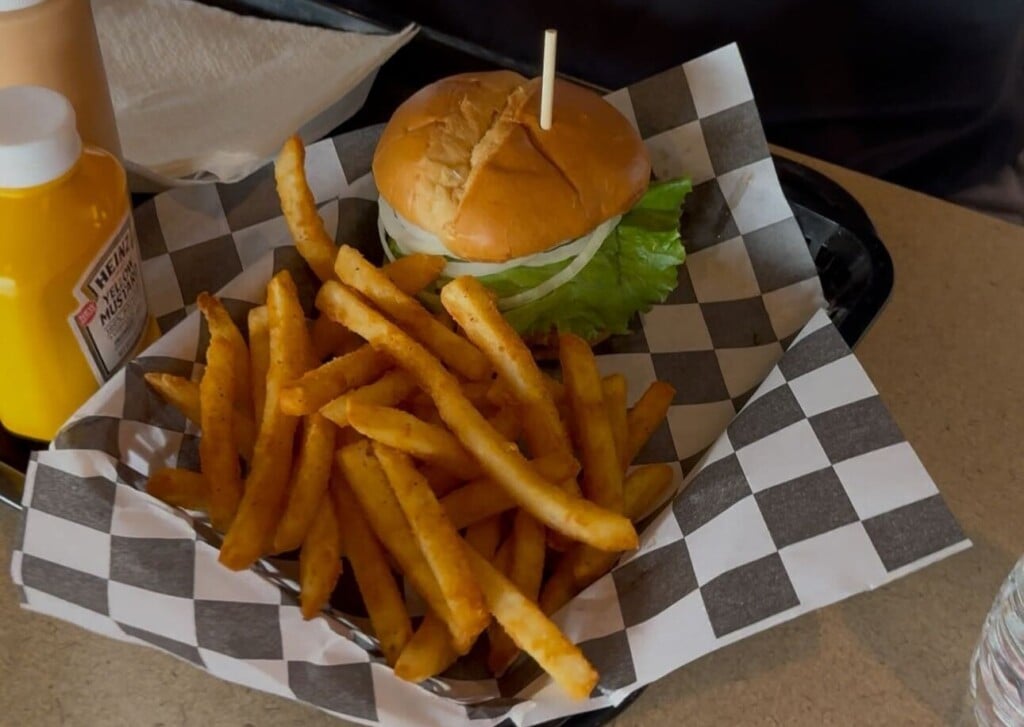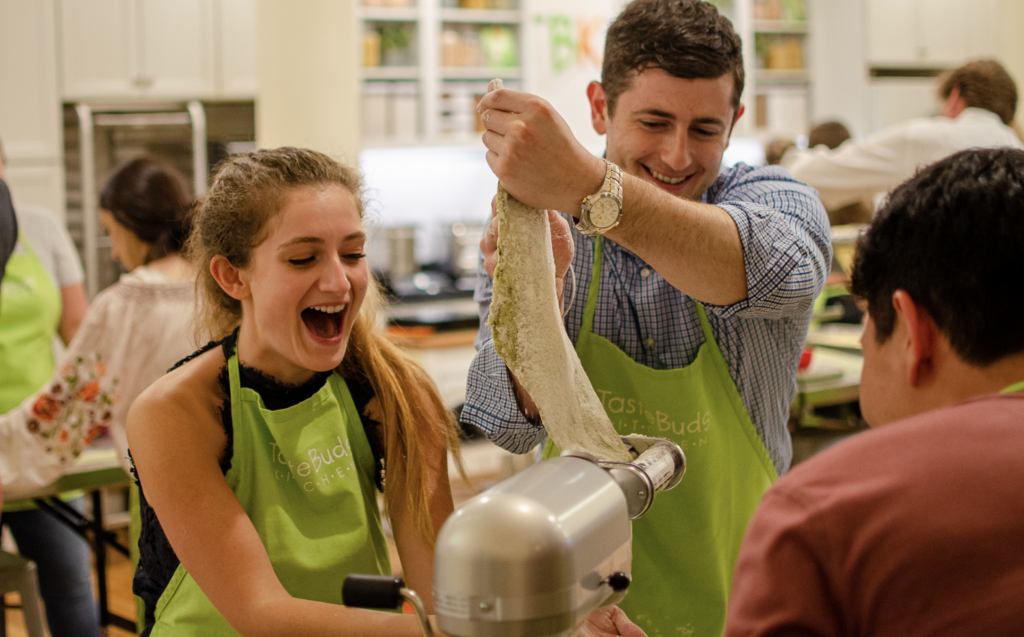Pete’s Garden redirects nutritious excess from Chiefs training meals to KC dinner tables
Each family goes home with a family-sized portion of a protein, starch, and vegetable

Former Chiefs Linebacker/Defensive End Tamba Hali volunteers to pack meals at Pete’s Garden // Photo courtesy of Kansas City Chiefs
What do Chiefs players and nightly attendees of New Theatre & Restaurant have in common?
Within a matter of hours, their leftover food at the end of the night ends up feeding children and families in need across the metro.
We’re not talking about the food scraped off their plates, of course, but the excess gourmet food that is prepared to accommodate large groups and provide them with options.
“We’ve had several [Chiefs] players ask us what happens to the leftover food. They’re always pleasantly surprised to find out we are able to donate it via food recovery with Pete’s Garden,” says Erin Wishon, Senior Executive Chef with Aramark at GEHA Field at Arrowhead Stadium.
How does this happen, and how can it possibly be safe? Enter: the team at Pete’s Garden.
Founded in 2020 by Tamara Weber, Pete’s Garden is a nonprofit food rescue operation headquartered in downtown Kansas City near the Convention Center. This organization acts not as a literal garden but as a middleman between restaurants and catering operations (such as Arrowhead and New Theatre) and local organizations that work directly with folks in need. In taking on this role, Pete’s Garden accepts responsibility for food safety, which is a top priority, along with providing nutritious foods and reducing food waste.
Despite the photo above, it’s not typically Chiefs players who do the redistribution, but staff and volunteers—often retirees, students, and corporate groups—at Pete’s Garden.
The soil is rich in Kansas City, but not equitably distributed
Food insecurity is a real concern in Kansas City, specifically for nutritious prepared foods.
Pete’s Garden reports that in Kansas City, one out of every six children is food insecure, yet 40% of those kids don’t qualify for federal nutrition programs like SNAP. To help bridge the gap, Pete’s Garden collects unserved prepared food from caterers, restaurants, and food service operations, then portions it out, adding labels and microwavable containers, to 18 local organizations such as Operation Breakthrough, Boys & Girls Club, Ronald McDonald House, Jewish Family Services, Phoenix Family, Literacy KC, and Greater KC LINC.
These family-sized portion meals are distributed to organizations that prioritize feeding children and families. Each family that wants to will go home with at least a protein, a starch, and a vegetable, ready to be heated up for dinner that night in the provided microwavable and reusable container—no cookware or container returns required. The complete meal from Pete’s Garden could include one family-sized container of each: tortilla-crusted halibut, mashed potatoes, and broccoli.
Yes, the container is plastic, but they’re not letting conceptual perfection stand in the way of practically feeding people.
Many elements of Pete’s Garden’s process are focused on circular resources and sustainability, not to mention its entire foundation of food recovery. However, practicality wins when it comes to the containers. They considered using aluminum foil, which they argued might be more likely to be recycled, but with many families relying on microwaves, that plan was crumpled. Plastic is not perfect, but it’s the best use of everyone’s resources for feeding folks at this time.
Part of the draw for organizations to partner with Pete’s Garden is the type of food it intercepts. It frequently carries a level of quality and nutritional impact that food pantries can’t match, simply due to the lack of funding they receive. Proteins, let alone gourmet chef-prepared proteins, are one of the most expensive foods. Yet at Pete’s Garden, it makes up a small majority of the food donated to them.
On the day I toured Pete’s Garden, the meals in progress featured sliced garlic beef, Hawaiian chicken with almonds and green onions, buffalo chicken wraps, and chicken tikka masala over a bed of rice and quinoa. “I don’t distribute anything that I wouldn’t feed my own kids,” says Weber.
These dishes may have come from the New Theatre, Arrowhead Stadium or training facilty, a catered wedding, Stowers Institute for Medical Research employee cafeteria, or even a school district the day before. With big budgets and people to impress, the food served at these sites is usually a menu of high-quality crowd-pleasers. Since these large kitchens are generally making complete meals, the ratios of main dishes to sides stay balanced and make packaging balanced meals easy.
Wishon, who is also a member of the Pete’s Garden Board of Directors, feeds Chiefs players and fans and is proud of being able to pass on surplus to the community.
“Our menu changes daily, so we are able to give a variety of foods, including fresh fruit, yogurt parfaits, sandwiches, and salads,” Wishon says. “All of our proteins are very high quality, hormone-free, all-natural, and local as much as possible. We have a captive audience, considering we feed the team five to six days a week in-season, so we try to offer a plethora of fresh fruits and vegetables and use every cooking method possible to keep it interesting.”
There’s room for all in the Garden
The variety of foods allows recipients to try things they otherwise may never have. One mother told Weber that her daughter had never liked green beans until having them in a Pete’s Garden meal. Trying foods prepared by chefs with quality ingredients can expand children’s palates.
“Lentils and beans are cheaper proteins than meat, sure, but if you’ve never tried them or had them prepared well, children or even adults may not be inclined to purchase those,” says Weber.
“We think of people receiving boxed macaroni and cheese and peanut butter sandwiches, and there is nothing wrong with that, but this is high-quality, gourmet food as balanced meals,” Pete’s Garden Director of Development Mindi Feltner says. Weber continues the sentiment, saying, “With the packaging and food quality, we want them to feel like this is food they could have gotten at any restaurant. It’s labeled, it’s dated, it looks like it could have come from Whole Foods.”
Weber and Wishon agree—There is no spirit of competition with traditional food pantries, only partnership. “Pete’s Garden complements organizations like Harvesters, and has provided us an outlet for our excess food that previously did not exist. Harvesters is well known in Kansas City and is a fantastic option for larger donations. By design, Harvesters does not process smaller amounts of fresh food,” says Wishon.
These meals are intended not for a specific income level or neighborhood, or as necessary shelf-stable foods, but to make it easier for families to gather around the dinner table and share a balanced meal, without the time or energy required for cooking. The distribution methods are entirely left up to the community partners. Pete’s Garden does not dictate requirements to receive meals—They trust that each organization knows the families they serve and what the needs are.
“Our hope is that on a Pete’s Garden meal night, the parent has more time to help the kids with their homework, read, or go to the park since they don’t have to worry about food,” says Weber.
Some restaurants have alternative plans for their surplus food. According to Weber, Jack Stack partners with Catholic Charities, and Garrozzo’s donates to Project Uplift. After a Greater Kansas City Restaurant Association meeting, a restaurant approached Joe Nicol, Food Recovery Program Manager at Pete’s Garden, to express interest in dropping their current partner due to inconsistency with pickup. Pete’s Garden stepped in, but not in a way that harmed the original benefactor. Nicol’s team now picks up food from the restaurant, packages it and keeps it safe, then distributes it to the original organization. This ended up saving them the burden of time, labor, and liability they once carried.
Roadblocks to sharing the harvest
There is a common misconception that it’s illegal for restaurants or caterers to donate leftover food. The Bill Emmerson Good Samaritan Food Donation Act of 1996 opened the door for food donations by removing the liability from the donor when made in good faith. It encourages donations of “food and grocery products to nonprofit organizations for distribution to needy individuals.”
It is indeed legal, but as of now, organizations equipped to handle the food are few and far between. Weber says there are only a handful of organizations around the country that redirect and package food like this, rather than just transport it as-is. She says the investment in a commercial kitchen prevents more from starting, but the concept is growing.
Let’s take a look at the process of getting food from Chiefs players’ lunch trays to the free food pantry for students at Pawsperity. Much of the process is a mere 36 to 48 hours from the time the food is prepared to when it is enjoyed by a local family.
According to a pre-arranged schedule, a driver from Pete’s Garden will visit Wishon’s team at an Arrowhead facility kitchen to pick up large containers of remaining food. They currently have one refrigerated van. Pete’s Garden prefers that the food be frozen, because it not only extends the time that thawing food is considered safe, but it also buys the restaurant more time to collect food.
For example, Mildred’s roasted breakfast potatoes don’t produce enough leftovers each day to be worth a trip for Pete’s Garden to collect. However, over a few days, the frozen surplus potatoes add up to about 75 pounds that would have otherwise been composted or trashed. Prepared food must remain at or below 40 degrees to minimize bacterial growth. Prepared fresh food, such as breakfast potatoes, should be discarded after seven days, even if it has been refrigerated.
Once the excess Chiefs training food reaches the linoleum and stainless-steel clad space at Pete’s Garden, Nicol weighs and records each donation. Receipts for tax purposes are kept for each donation partner.
Pete’s Garden’s staff adapts daily to provide the most balanced meals to Kansas City families. When they have made a plan to maximize the donated food for optimal nutrition, labels are created and affixed by volunteers to new food-safe packages. They all wear gloves and a hair net or hat. Some volunteers and staff generously pack food into the reusable containers, while others clean the catering-size containers that the food was donated in.
Food is not necessarily packaged in the same combination it was collected. For example, a serving of quinoa from the Stowers Institute was paired with chicken stir-fry from a local restaurant on the day of my visit. Then, that package might be distributed the next day alongside a container of seasonal grilled mixed veggies. Some food combos will have a few dozen packages, while others may have only a handful. This variety is passed on to the recipient families, who get to choose the meals themselves based on what fits their family’s needs.
Salad greens and pre-cut fruits and vegetables are not typically accepted from donation partners. They are more likely to grow bacteria, or at the very least, go limp or soggy quickly. Raw meats and near-expiration dairy and eggs are not accepted for safety reasons, while bread and sweets are not accepted for menu preference reasons.
This brings up the major hurdle that prevents other organizations from doing this work: food safety. Handling prepared foods safely is no easy task, and for Pete’s Garden’s role, it all comes down to timing and temperature. Big picture: Recovered food should be distributed within just three to four days of it first being made, since families may not eat the food the same day they receive it. Zooming in, the containers of recovered food should be kept refrigerated, with minimal time outside of refrigeration, to ensure food temperature does not get above 40 degrees.
In addition to regular inspections from the Kansas City Health Department, Nichol frequently tests the foods with a temperature gun and keeps detailed records of collection times. “I test food temperature randomly about five or six times a week. We’re cognizant of time limits because we want to give our distribution partners as much flexibility as possible,” says Nichol.
Next, a Pete’s Garden driver will deliver a load of packaged meals to distribution partners that hold them in refrigerators until they’re picked up by families. With some partners, a volunteer will drive downtown to Pete’s Garden to pick up the meals. In the winter, the process is more relaxed, but in the summer, the drivers almost rush back to the distribution site so the food can be refrigerated quickly.
The rest of the journey is between the community partner (Pawsperity in this example) and their students.
An organization like Pawsperity knows that food insecurity is linked to larger societal and political issues, which is why they include meals and food assistance in their curriculum. In addition to their tuition-free career training, Pawsperity employs a staff of social workers to support students with wraparound services like case management, housing and food assistance, and medical care to help remove barriers to receiving an education. This holistic approach is found at many of the organizations that Pete’s Garden supports.
How to help tend the Garden
Few things are as unifying as food. Though Pete’s Garden operates out of a church building and serves a variety of religious organizations, it has no religious affiliation itself. They pay rent for the space and choose to keep the church’s food pantry stocked with balanced meals.
For those who want to get involved, Pete’s Garden has volunteer slots available in two-hour commitments during the week at their downtown location. Volunteers package up food, add coordinating labels, and help clean the transport containers. During my visit, about ten teens and adults were there representing the National Charity League and the Young Men’s Service League, in addition to some individual volunteers.
As one would expect, monetary donations are also needed. Food recovery is just one of Pete’s Gardens’ services.
They also run Kids Feeding Kids, which operates in 43 schools across five states. The program trains students in culinary classes to cook in bulk—at least 250 servings—and provide those meals to families with children in their district. Weber notes that Patrick Mahomes was the seed funder for this project.
The greatest need, however, is food. Pete’s Garden needs more restaurant and catering partners. The organization reports that only 20% of restaurants donate unserved surplus food, and that surplus food from Kansas City restaurants alone could provide up to one million meals to hungry families.
Currently, all major sports stadiums in KC have partnerships with Pete’s Garden, but there is still a gap in restaurants and corporate/catering operations.
Wishon sums up the impact from all sides and the next steps to expand these hunger-fighting strategies:
“As cooks, we never want to see our work go to waste. As an organization, the Chiefs want to invest in their community. Pete’s Garden has filled a huge need for us, and we desperately want to share that information with other venues that have prepared products to donate. It’s been incredible to be able to get this product to those in need.”
If you’re a restaurant or caterer who currently sits in that 80%, Pete’s Garden might be the connector you need to redistribute food waste with no extra work for your kitchen staff. But for the rest of us, we can champion these programs and destigmatize utilization. We can donate our money and our time. We can vote for policies that feed our neighbors and address systemic inequalities.
While we don’t have the opportunity to harvest corn on a farm or work the grill in a restaurant whenever we feel like it, volunteering at Pete’s Garden is one way to feel connected to your food system and community. If you can stand for two hours and lift a few pounds, bring your family or coworkers to become a connector between Kansas City dinner tables.
Only when you’re fully healthy, though, promise?
You don’t have to know who it was first made for, or who it will serve, but you will know that you played a role in redistributing excess in a way that feeds people well.










